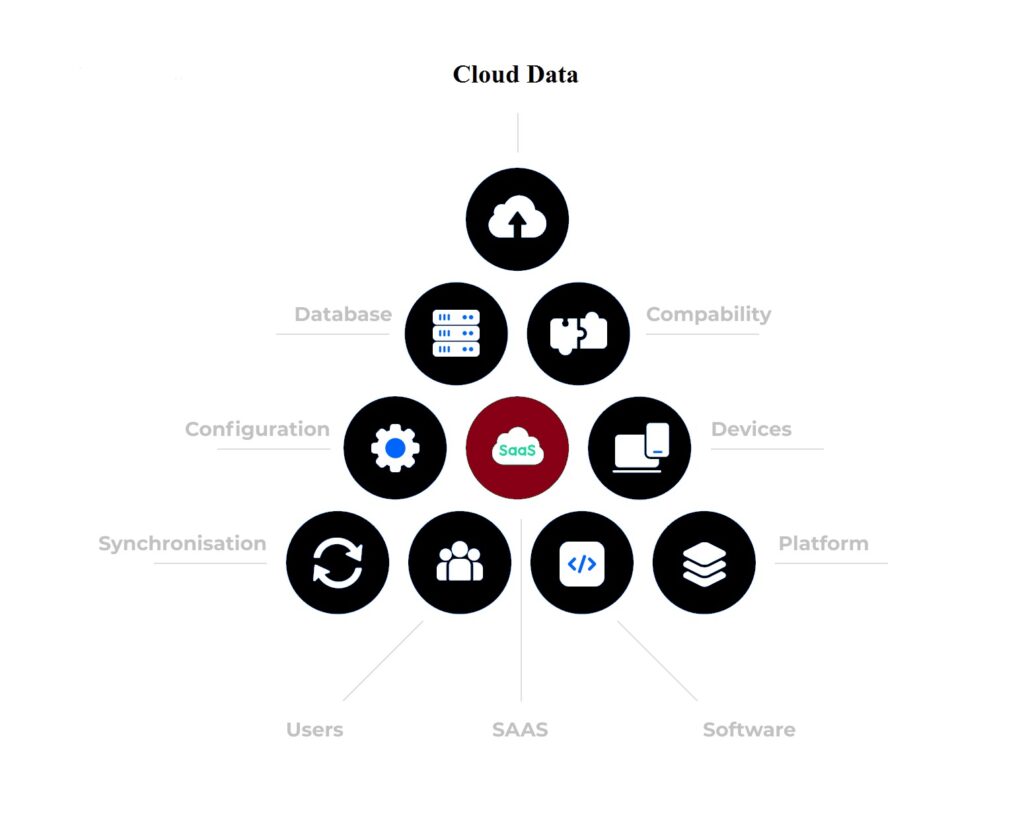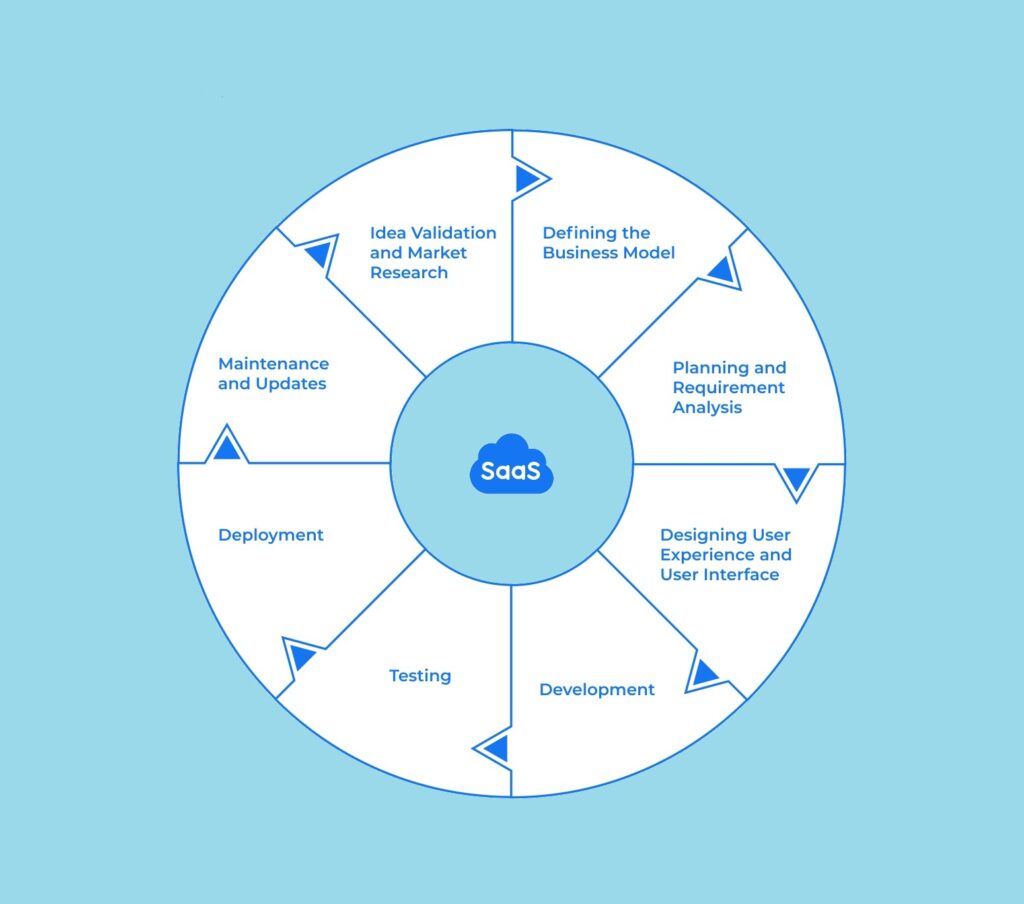A SaaS application is a cloud-based software solution that users can access via the internet, eliminating the need for traditional local installations or extensive on-premise infrastructure. By Purchasing the service, users enjoy seamless access through web browsers or APIs while the provider manages maintenance, updates, and security. This innovative approach aligns with the principles of what is SaaS application development, focusing on creating scalable, flexible, and user-friendly solutions tailored to meet the evolving needs of businesses and their customers.

SaaS Application Development Process
The journey of SaaS application development requires a methodical approach to ensure the final product is robust, scalable, and aligned with business objectives. Let’s explore the critical steps involved:
Idea Validation and Market Research
Validate your idea by analyzing market demand, understanding your target audience, and evaluating competitors. This step helps you identify market gaps and ensures your solution aligns with user needs, reducing the risk of failure.
1)Defining the Business Model
Establishing a revenue strategy is pivotal. Options include subscription-based tiers, freemium models, or pay-per-use pricing. A well-defined business model ensures profitability while offering flexibility to cater to diverse customer needs.
2)Requirement Analysis
Comprehensive planning is the backbone of custom SaaS application development. Clearly define the features, functionalities, and technical requirements of your application. Prioritize these elements to create a roadmap that ensures the development process remains structured and goal-oriented.
3)Designing User Experience and User Interface
Exceptional design is at the core of user satisfaction. Create a user-friendly interface and engaging experience that promote seamless interaction with your application. A thoughtful UX/UI design can significantly enhance user retention and product adoption.
4)Development
Begin the technical implementation using appropriate technologies and frameworks. Ensure the architecture supports scalability, robust security measures, and optimal performance. Adopting agile development methodologies allows for iterative improvements, enabling flexibility to refine the product during the development cycle.
5)Testing
Comprehensive quality assurance is essential to ensure your application performs reliably. Rigorous testing identifies and resolves bugs, guaranteeing compliance with specified requirements. It also ensures a seamless experience for end users.
6)Deployment
Once tested, deploy the application to a live environment. This stage involves setting up hosting, configuring environments, and ensuring all systems are fully operational. It is crucial to provide a smooth onboarding experience for initial users.
7)Maintenance and Updates
Launching is just the beginning. Regular maintenance is essential to keep your application competitive and functional. Introduce new features, address emerging security challenges, and optimize performance to meet evolving user expectations.

Challenges to Consider Before SaaS Application Development
Embarking on SaaS application development offers immense potential but also presents unique challenges that require careful planning and execution. Addressing these challenges proactively is crucial to creating a successful, reliable, and user-friendly solution. Let’s explore the key considerations:
1)Data Security and Privacy
Protecting user data is one of the most critical aspects of SaaS. With increasing concerns about cybersecurity, implementing robust encryption, adhering to industry regulations, and conducting regular security audits are non-negotiable. Ensuring compliance with frameworks such as GDPR or HIPAA, depending on your target market, further builds trust and credibility among users.
2)Integration with Existing Systems
SaaS applications often need to integrate seamlessly with users’ existing software or workflows, which can be a complex task. Designing flexible APIs and considering potential integration challenges during development are essential steps. By prioritizing interoperability, you provide SaaS application development solutions that enhance the user experience rather than disrupt it.
3)Scalability
As your user base expands, the demands on your application increase. Ensuring your SaaS platform can scale efficiently without sacrificing performance is critical. Proper system architecture, cloud resource optimization, and load-balancing strategies are key components of full-cycle SaaS application development services that can help you handle increasing traffic and data volumes.
4)User Experience
A seamless, intuitive user experience is at the heart of SaaS success. From responsive design to user-centric features, the application must cater to the diverse needs of its audience. Investing in thorough UX/UI research and design ensures your product is easy to use, enhancing adoption rates and retention.
How to Choose a SaaS Application Development Company
Choosing the right SaaS application development company is a pivotal step in ensuring the success of your project. With so many options available, finding a partner who aligns with your business goals and technical requirements can make all the difference. Here are the essential factors to evaluate when choosing:
●Experience and Expertise
Look for a SaaS application development partner with a strong track record in the field. Their portfolio should showcase experience in creating SaaS solutions that are scalable, secure, and user-friendly. Industry-specific expertise is an added advantage, as it ensures the team understands the unique challenges and requirements of your market.
●Technical Proficiency
A competent development team should be skilled in the latest technologies and frameworks used in SaaS application development, such as cloud platforms, API integrations, and scalable architectures. Their ability to follow best practices ensures the delivery of a robust and efficient product.
●Client Testimonials and Case Studies
Reviewing client feedback and case studies provides valuable insights into the company’s reliability and quality of work. This helps you assess their ability to handle complex projects and deliver solutions that meet client expectations. A reliable SaaS application development team will have a proven history of successful collaborations and satisfied clients.
●Communication and Support
Effective communication is crucial throughout the SaaS application development process. Your chosen partner should maintain clear and consistent communication, keeping you updated on progress, challenges, and milestones. Additionally, ongoing support and maintenance are essential to ensure your application remains competitive and functional after launch.
●Customization and Flexibility
Your business and its requirements are one of a kind. The right SaaS application development partner should provide tailored solutions rather than relying on one-size-fits-all approaches. Their ability to customize features and adapt to your evolving needs is critical to ensuring the long-term success and scalability of your SaaS platform.
●Focus on User Experience
A great SaaS platform prioritizes user satisfaction. Choose a SaaS application development team that emphasizes creating intuitive designs and seamless user experiences. Their deep understanding of how users interact with SaaS products will ensure your application not only meets user needs but also stands out in the competitive market.
SaaS Application Development Cost
The SaaS application development cost varies significantly based on factors such as complexity, features, and development approach. Developing a basic Minimum Viable Product typically starts at around $100,000, while more comprehensive and feature-rich solutions can exceed $500,000.
These costs reflect the investment required to create a scalable, secure, and user-friendly SaaS product that meets market demands.
Several factors influence the cost of SaaS web application development, including:
●Design Complexity
Advanced and unique designs increase development time and costs.
●Integration Requirements
Ensuring seamless compatibility with third-party tools and existing systems adds complexity.
●Compliance Considerations
Meeting regulatory standards like GDPR or HIPAA demands additional resources.
●Team Expertise
The skills and experience of the development team directly impact costs.
